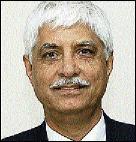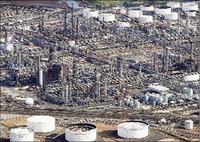Zia Mian, Contributor 
Mian
Some readers have pointed out that my March 16 article did not address the impact of increased oil demand in China and India.
It is estimated that, in 2007, the Chinese economy grew at 11.4 per cent and the Indian at 8.6 per cent.
In 2008, growth in both economies is expected to slow down and is projected at 9.9 per cent for China and at eight per cent for India.
The fact is that the Brazil, Russia, India and China (BRIC) factor will continue to impact both the demand and the price of oil.
In January 2008, Chinese and Indian oil imports were 3.7 million barrels per day (mb/d) and 2.4 mb/d, respectively.
Other factors

An oil refinery in Elizabeth, New Jersey, is shown in this aerial photo of August 29, 2007. - File
In addition, there are other factors that also influence the price of oil. These, among others, include hurricanes and weather (impacting the operations of rigs and increased demand for heating oil during colder winters); limited excess production capacity in oil-producing countries (Saudi Arabia being the most probable source).
Others are the Nigerian excess capacity which is shut in and remains under constant terrorist threats); increased oil nationalism (Iran, Russia, and Venezuela) coupled with energy independence stances of oil-guzzling economies; and fluctuations in the level of Strategic Petroleum Reserves (SPR) or OECD inventories (the governments substituting for commercial reserves).
The Organisation of Petroleum Exporting Countries (OPEC) analysis shows that in 2008 the world demand for oil is projected at 86.97 mb/d, an increase of 1.2 mb/d over 2007 level.
Non-OPEC production is projected to average at 55.3 mb/d (including OPEC natural gas liquids (NGLs) or condensates).
The demand for OPEC supplies is projected to average at 31.67 mb/d. In February, the OPEC production (including Iraq) was 32.09 mb/day.
In February, the OECD stocks increased by 45 million barrels (mb) to 2,617 mb. The US inventories averaged at 997 mb, with gasolene stocks above five-year average.
Notwithstanding the supply/demand balance and stock levels, the rally at the NYMEX has remained uninterrupted.
Last week, the crude oil price surpassed the US$ 111 per barrel mark as investors flocked to pour funds into the paper oil-market.
On March 13, the price of OPEC Reference Basket of crudes (weighted average spot prices for 11 crudes) shot to US$ 102.39 per barrel, registering a 22 per cent increase in the spot price over the past five weeks. The current oil prices are, therefore, defying the physical supply demand reality.
It is noteworthy that the price of oil is quoted in US dollars, and so are all settlements.
As long as the concerns remain that the US dollar would continue to weaken against the major currencies, investors would seek to put the dollars where the value is likely to be maintained.
It is within this context that the foreign exchange trading and commodity markets have flourished (see table).
Without dwelling on the economic theory behind the daily/future spots, arbitrage, contango or backwardation, let me quote from a National Bureau of Economic Research study that "the 'futures' do not appear to predict subsequent movements in energy commodity prices" (Predictive content of energy futures by Chinn et al. 2005).
Different trend line
However, the fact is that the oil prices are now on a different trend line.
Producers love them and most likely are squandering their windfall profits not in poor developing economies but in the developed economies.
They are busy building islands in the ocean, seven-star hotels and, you name it, while you and I have to choose between buying a patty or a litre of gasolene.
In his statement on March 4 to the US Senate Committee on Energy and Natural Resources, Guy Caruso, (administrator, Energy Information Agency, US Department of Energy) said that, "In the reference case, real world crude oil price (defined as the price of light, low sulphur crude oil delivered in Cushing, Oklahoma, in 2006 dollars) would decline gradually from current levels to $57 per barrel in 2016 ($68 per barrel in nominal dollars), as expanded investments in exploration and development bring new supplies to the world market. After 2016, real prices will begin to rise, as demand continues to grow and higher cost supplies are brought to market. In 2030, the average real price of crude oil $70 per barrel in 2006 dollars, or $113 per barrel in nominal dollars."
Considering that last week the nominal price exceeded the $111 per barrel mark, it is a bold statement to make.
However, the chart presented by Caruso shows that the 1980 peak (in 2006 dollars) was short-lived and was broken only in March 2008.
Oil from Canadian tar sands is now commercially viable and a lot of investment is riding on that prospect.
Change supply mix
Notwithstanding, Jamaica is currently over 94 per cent dependent on imported oil to meet its energy needs. This over-dependence on oil is a serious threat to our energy supply security at affordable prices.
If Saudi Arabia ever became a hot spot, we would need our entire GDP to sate our appetite for oil.
Jamaica needs immediate policy actions to change her energy supply mix.
Weekly average price (OPEC Reference Basket)
Week
ending US$p/barrel
25/01/2008 84.91
01/02/2008 87.84
08/02/2008 85.58
15/02/2008 90.06
22/02/2008 92.82
29/02/2008 94.74
07/03/2008 97.29
14/03/2008 100.96
Source: OPEC
Zia Mian, a retired senior World Bank official, is an international consultant on information technology and energy. Send your comments to mian_zia@hotmail.com.

